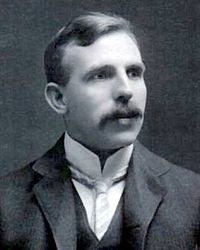Ernest Rutherford
Scientist
"Lord Rutherford" redirects here; not to be confused with Lord Rutherfurd or with Andrew Rutherford, 1st Earl of Teviot.Ernest Rutherford, 1st Baron Rutherford of Nelson, OM FRS (30 August 1871 – 19 October 1937) was a New Zealand-born British physicist who became known as the father of nuclear physics. Encyclopædia Britannica considers him to be the greatest experimentalist since Michael Faraday (1791–1867).In early work he discovered the concept of radioactive half-life, proved that radioactivity involved the transmutation of one chemical element to another, and also differentiated and named alpha and beta radiation. This work was done at McGill University in Canada. It is the basis for the Nobel Prize in Chemistry he was awarded in 1908 "for his investigations into the disintegration of the elements, and the chemistry of radioactive substances".Rutherford moved in 1907 to the Victoria University of Manchester (today University of Manchester) in the UK, where he and Thomas Royds proved that alpha radiation is helium nuclei. Rutherford performed his most famous work after he became a Nobel laureate. In 1911, although he could not prove that it was positive or negative,he theorized that atoms have their charge concentrated in a very small nucleus,and thereby pioneered the Rutherford model of the atom, through his discovery and interpretation of Rutherford scattering in his gold foil experiment. He is widely credited with first "splitting the atom" in 1917 in a nuclear reaction between nitrogen and alpha particles, in which he also discovered (and named) the proton.Rutherford became Director of the Cavendish Laboratory at Cambridge University in 1919. Under his leadership the neutron was discovered by James Chadwick in 1932 and in the same year the first experiment to split the nucleus in a fully controlled manner, performed by students working under his direction, John Cockcroft and Ernest Walton. After his death in 1937, he was honoured by being interred with the greatest scientists of the United Kingdom, near Sir Isaac Newton's tomb in Westminster Abbey. The chemical element rutherfordium (element 104) was named after him in 1997.
Personal facts
| Alias (AKA) | 1st Baron Rutherford of Nelson |
|---|
| Birth date | August 30, 1871 |
|---|
| Birth place | Brightwater , Tasman Region |
|---|
| Date of death | October 19, 1937 |
|---|
| Place of death | |
|---|
| Education | |
|---|
| Known for | Rutherford backscattering spectrometry |
|---|
